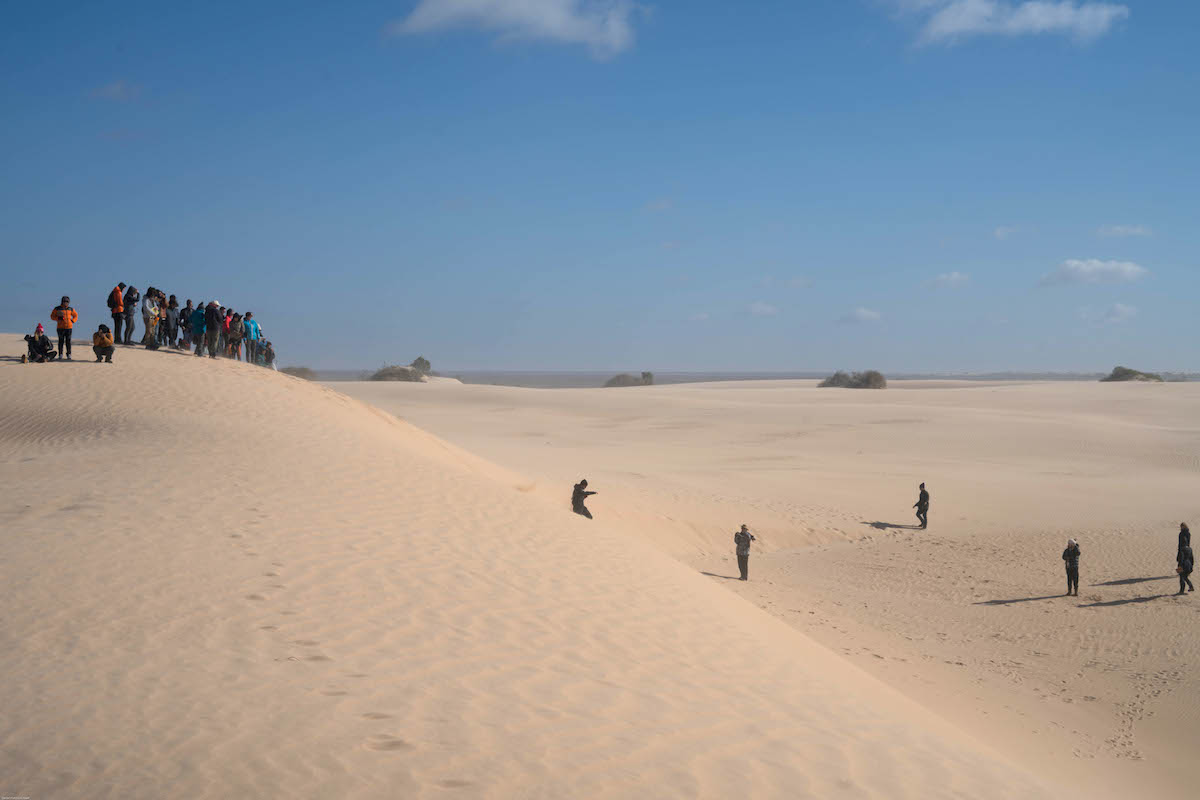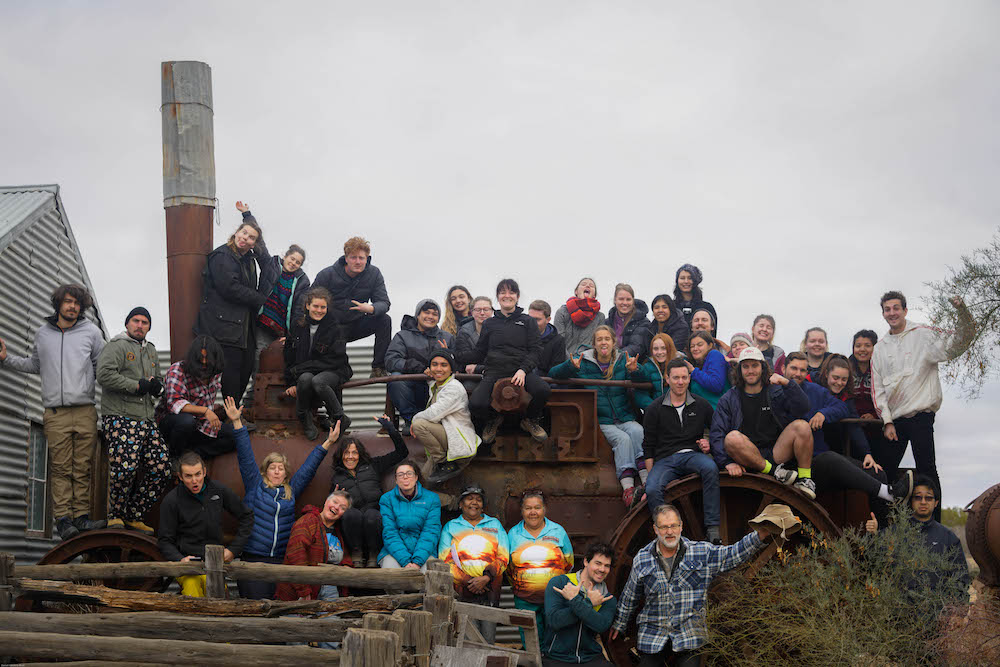Associate Professor Andy Leigh is well-versed in the process of taking her undergraduate students on ecological field trips. Before the curriculum even begins, there are the logistics of accompanying nearly 40 students on the excursions, with many of the students navigating very new experiences. On the two week Semi-arid Ecology road trip (with the most recent trip occurring in July 2018), which traverses regional and remote areas of NSW, Andy explains “they’re in really close quarters with thirty-five other students plus staff, so it’s this little melting pot. They have to learn how to get on with people, they have the responsibility of cooking for everybody, getting up early, packing up all the gear, and going out. And we’re learning about the landscape, how it’s put together, the ecology, plants and animals”. It’s a learning opportunity in many different ways.
Where the students go
There have been many of these trips through the wilderness – Teaching Associate in the Science faculty, Peter Jones, has been running them for around forty years. The arid zone ecology trips are particularly special, as not only is this Andy’s specialty area, but it also provides a rich opportunity to engage with the Indigenous experts of the areas they visit, who know the land’s history and formation more intimately than anybody else. It’s a winding journey through a number of places, important both ecologically and historically. Over two weeks, students travel over three and a half thousand kilometres, to destinations such as Narrandera, Lake Mungo, Kinchega National Park, Mutawintji National Park and the Strzelecki Desert. And they learn about and experience things that can’t be described in a textbook.

Learning from those who know best
Recalling the Indigenous speakers the group heard at Lake Mungo, Andy said “They show us midden sites, ancient fireplaces, fish bones, but there’s also bones of extinct megafauna, like the giant wombat (diprotodon). So we have a speaker there, teaching students about things that you might otherwise just walk past without understanding the history: it needs to be pointed out to you. And an Indigenous Elder – sometimes they’re an Elder from the area, sometimes they’re Indigenous tour guides – will pick up something and explain that it was a heat bead, a piece of a termite nest or a particular rock, that had been used to cook something. Other times it might be little flakes of silcrete, which were once tools. Many people wouldn’t know that silcrete isn’t naturally found at that lake bed site, but students learn from our guides that it’s been brought there from quarries up north.”
They also learn the importance of moving through the landscape with respect and being aware of cultural protocols while carrying out their work. “Dale and Dot were the two women who guided us through our field work at Kinchega National Park. They said well, if you’re going to be out there running transects on our country, we need to be out there making sure that you’re not traipsing all over our ancestors’ sacred places. And we couldn’t agree more! We told them where we wanted to run our transects and they walked the transect first to make sure”. This tour, arranged by Subject Coordinator Claire Sives, was to be one of the most memorable parts of the trip.

During one of these transects, while Dale and Dot were inspecting the line, they actually found something new. “It was an ancient fireplace, with burnt termite mounds that had been used to cook fish, and they explained to students how fish had been cooked there. The students were very careful to not walk in that area…they were incredibly respectful and really quite moved by it.”
There’s no roadmap to the experience students might have while being led by the Indigenous speakers who guide them through the area. And on this trip, guides Dale and Dot were so impressed with the students that they gave them the opportunity to learn about a particularly special, sacred place – a repatriation site, where the remains of their ancestors are repatriated and protected from erosion, through a process of reburying them and planting native plants over the site to prevent them from being disturbed.
“They evoked an image of what it would have been like to be grinding acacia seeds on a grinding stone, with kids playing all around, where the parents could see where they are – a nice safe place, with shady trees. And one of the students said ‘but there’s bones of people there, what are they there for, so close to the camp?’. And Dale said well, for a start, we’re not going to carry them around because they’re heavy, but anyway, what’s wrong with having them close to us? If they were walking and an old person died, they buried them there. The only time they wouldn’t do that, is if there was a baby, and they would pick the baby up, and carry them with them, because they didn’t want them to be alone. And then they’d bury them with other people, who were buried nearby. Students were really moved by that. There were students in tears, it really changed their experience.”

At Kinchega, students were invited to explore a 200-year old woolshed that has been enshrined in history as a world heritage site, and to counter that framing with what they were learning about Indigenous history, and the living spaces which bear no official certification of historical significance, but represent tens of thousands of years worth of history. At Mutawintji, speakers showed the students cave paintings and stencilled handprints, and shared Dreamtime stories over dinner at the campsite.
Indigenous knowledge in science education
Andy pauses for thought when asked how much science education interacts with the traditional owners of the land. “I think we’re starting. In the higher education sector, I don’t know that we’re quite there yet. The Australian Rangelands Society and the Ecological Society of Australia have Indigenous Knowledge presentations and symposia at every conference. So, in those sorts of forums, the Indigenous knowledge is part of the conversation alongside science. In science education, I don’t know too much about how it’s going across the sector, but I don’t think it’s there yet.”
Andy concludes that the only way forward is for science to increase these types of interactions. “As educators, we need to keep including Indigenous knowledge on the agenda when we design curriculum, keep working with Indigenous people to understand its role and how long people have been out there gaining this knowledge and respect that. In environmental science, if you’re going to be working on the land, there’s just no excuse for not understanding it holistically.”
Feature image by Dan Hutchins-Read.

Super excited to see Claire as a subject coordinator (former U:PASS leader!). But honestly, it would be amazing to run a trip like this for staff. I’d be interested (though not July cos frankly that’s way too busy).